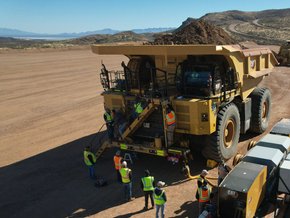Diamonds (and uranium) are Namibia’s best friend

This comprehensive report The Mining Industry in Namibia 2023 provides valuable insights into the industry’s size and current state. It covers a wide range of aspects, including major mining activities, the diverse spectrum of minerals, prominent companies, ongoing exploration efforts, project developments, and corporate actions within the sector.
The Mining Industry in Namibia
Namibia’s mining industry grew strongly in 2022 in turnover and share of GDP, largely due to a 44% growth in diamond production. Exploration expenditure increased on the back of growing interest in Namibia’s critical minerals, due to the global energy transition, and uranium where a supply deficit is forecast. The mining industry is dominated by diamond and uranium mining, and more than 70% of Namibia’s diamonds are extracted from the sea. According to De Beers, 95% of the diamonds pulled from the seabed near Namibia are of gem-quality. This compares to just 20% of gem-quality diamonds coming from De Beers’s top mine in Botswana. Some experts estimate that the diamonds in the ocean have endured marine erosion for such a long period that only the gem-quality ones would be able to remain intact.
Mineral exports are predominantly in semi-processed or raw forms. While several new projects are slated to commence production in the coming years, some copper mines have ceased operations in recent times..The industry also saw an uptick in exploration expenditure, driven by heightened global interest in Namibia's critical minerals, influenced by the ongoing global energy transition, as well as the uranium sector, which faces an anticipated supply deficit.
Regulatory Changes
The government said in June 2023 that it may in future take minority stakes in mining projects when issuing their licences to gain more value from the country’s mineral resources. Additionally, Namibia introduced an embargo in June 2023 on the export of unprocessed critical minerals to ensure value addition prior to exportation. Proposed legislation encompasses an increase in royalty rates, the integration of mining charter provisions, and the implementation of a windfall tax. Changes to the VAT Act are set to reduce exploration costs.
However, the industry faces challenges such as intermittent water supply disruptions, particularly in regions housing uranium mines, along with elevated input expenses. Nonetheless, exploration expenditure continues to rise, primarily due to the growing interest in critical minerals and uranium resources, indicative of a dynamic and evolving mining sector in Namibia.
Challenges
Some of the challenges the industry is experiencing are water supply interruptions, especially in the areas where the uranium mines are, and high input costs. Exploration expenditure is rising, largely due to increased interest in critical minerals and uranium.
Report Coverage
This report on the mining industry in Namibia includes information on the size and state of the mining industry, major mining activities and minerals, notable companies, exploration and project developments and corporate actions. There are profiles of 19 companies including diamond producers De Beers Marine Namibia and Namdeb Diamond Corporation, uranium miners such as Rössing Uranium and Swakop Uranium, cement manufacturers such as Ohorongo Cement, zinc miner Rosh Pinah and copper miner Trigon Mining.
- Tin production at Andrada Mining reaches record levelsSupply Chain & Operations
- Rajant & Sandvik partner on De Beers' Venetia Diamond MineAutomation & AI
- Mountain Province Diamonds announces record quarter resultsSupply Chain & Operations
- AfriTin Uis mine lithium results 'exceed expectations'Supply Chain & Operations






